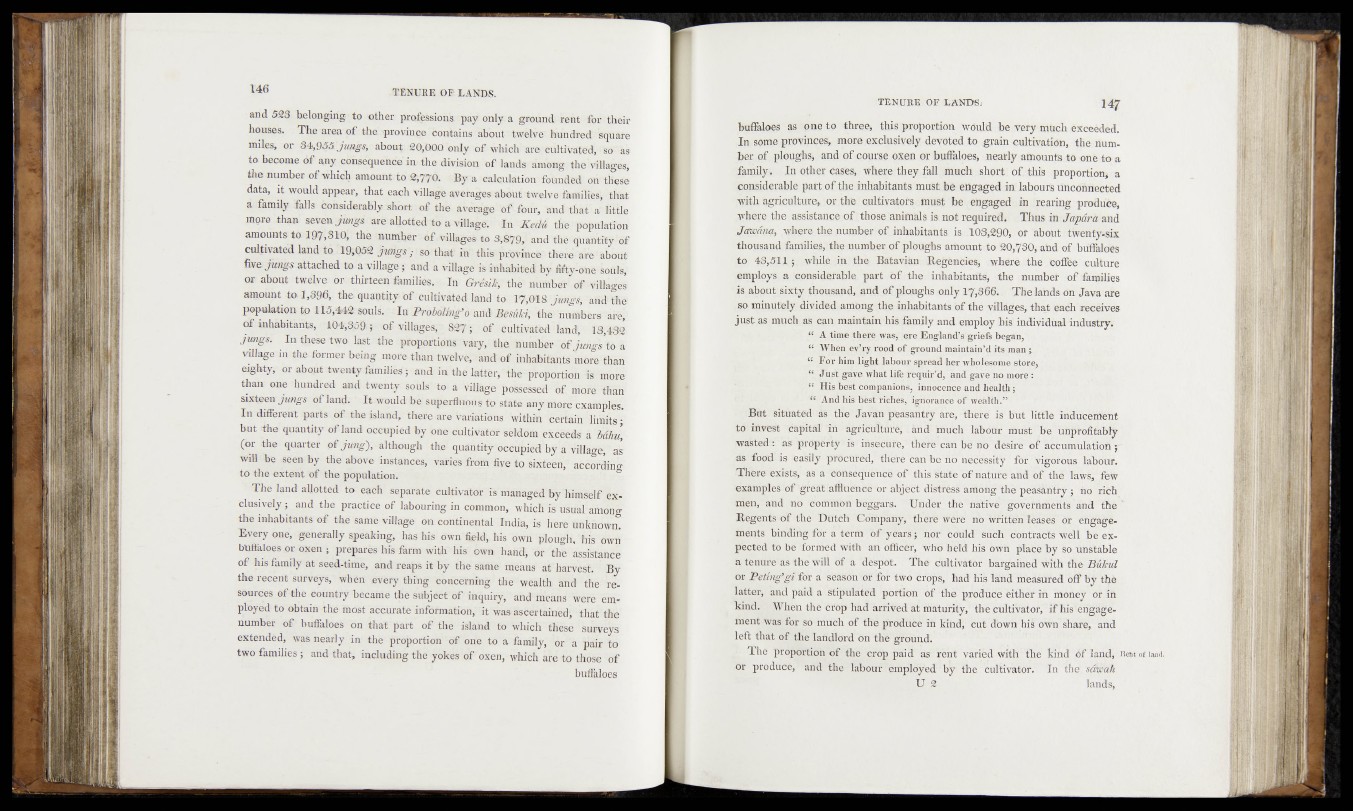
146 TENURE ©E LANDS.
and 523 belonging; to ether profession's, pay only a ground rent ^ ^ tb e ir
houses. The area of fee ^p^vinge Contains'about- twelve bandied'Square
miles, n about 2Q,OGO enly- oewhieh’ arO.'Oldti>aie^ -so as
to become of aay .cbnsequene© ia- the division o f lands among theH^Hages,
the number of which amount to 2;77& By a calculation fb&nded on these
data, it would appear, that each village averages about twelve families; that
a family -Ms considerably short of the average o f fouF, and that a‘ Kltle
more than seven jimgd axe allotted to- a village. In KeM the population
amounts-to I ^ S lU j the number. of .villages to 3^ 9, and the qUahtity’e'f
euljivated land to S ^ p f jm ig sy so that' in this province feefe^fe’hbout-
fweyMMgrattaehed to a village;’ a»‘d a village is inhabited by Mtv-one feu®,
m afeont twelve » th»teen Emilies. In Grisilt; the' nuthbe/ of^f&oes
amount to 1,30«; the' land to and fee'
p o ta tio n $p 415,442 souls: -In J VoUUngo and BesAki, fee- hmribtew '*&/
off inhabitants, off j j j g j lfe, 88?'» i f cultivafed'-iand, 1» , »
jm g s, Infeefetwn l » f the proportions- Vary, the number 6B jtmgs to a
village in the. former being more than twelve, andtoff inhabitants more than
eighty, or about twenty families * and in‘the latter/ the- proportion W W
than: one hundred and twenty sqals' to a viSage ;pokhM''of/nihl^ than
sixteen jtm gs i f land. Itwould be superfluous to state any more example's^
Indifferent parts of .the island, there-are variations within Certain-!li^ fc ;'
hut fee quantity of land occupied by one cultivator seldom exceeds- a i&hu,
jm a j||| g a rte r of jung), -although th.e quantity'occupied T>y a village as
wifi -be aeen by the above instances, varies from five to sixteen/ according
tg -fee extent 'off' fee population. -'r/.' * -
The land allotted to each separate cultivator”® managed h ^ im sh lf exclusively;
and the practice of labouring in common, which 1? iiSuaPaihOTg
the inhabitants of the same-village- on continental India, adhere unknown.
Every one, generally speaking, has bis own field, his own plough/his dwn
buffaloes <or °5fen ; prepares his form with his own hand, or thTe' assistance
off his family at seed-time, and reaps it by the same' means1 at 'harvest. By
the recent surveys, when everything concerning fee wealth, and the resources
of fee country became fee subjeefbf inquiry, and-means ’were employ
fed-to obtain the most accurate information/|it was Ascer tained; that' fe4’
number off buffaloes on thatpart of the island to which these surveys
extended; was nearly in the proportion of one to a family, or ' a pair to
two families ; and- that, including the yokes o f oxen, which are -to those of
buffaloes
TENURE OF LANDS; 147
buffaloes as one to threes fek proportion wduld. be very much exceeded.
In some provinces) -more ..exchisively d.eyöted to grain cultivatión, the number
of ploughs; and ofcourse oXen or buffaloes, neatly amount's tö-oné to a
family* In other Cases,, where-they fall much short; of. this proportion; a
considerable part,of fee inhabitants must be engaged in. labours unconnected
with agricultures, .or .fefecultivators,.must be engaged in rearing produce,
Where theasristaneenfl those animals is not required: Thus in Japara and
Jrnam , .where the number'of .inhabitants, is 103,290, or "about twenty six
thousand faniilies, ; the number, of ploughs amount to 20,Y30, and of buffaloes
I©- ^ » S l j while in fee Batavian tiegëncies, wherè .the Coffée culture
..employs a .considefable. part qf:;fee.• inhabitants, fee number of families
is.abouti.sixty thousand, .and of ploughs only l?,3(s§/ The lands on Java are
so minutply.-divided ambng-fee inhabitants of the -villages, that each receives
jüpfas-much as. can. maintain/his family and employ bis' individual industry.
;o) “ . A time there wasy ere. Englaûdk-'griefs began,'
forinr (WhenÆv’ry rood of ground maintain’d its man Sïwj
. / c Ror him light labour spread her wholesome store,
m JjsSS Just,gave what life requir’d, br/L gave no more': ,
■UByS His nest companions, innocence;and health ;
“ And his bést ricWeS, 'igborancë oT wealth.”
But s i t ó a t ë d fee Javan peasantry àre,‘tlfeië' is but little inducement
to invest èàpitâ'1 in- agricüîWre, knd rÉ’udh labour must''b’e unprofitabty
wasted'.: aif- property ' is - iriséciiih/ feérë'cari feê'flb d’èsire óf âccumulàtioii y
as food isi îfealily ptbcûîed/ there can Be no nëdbssitÿ ' for vigbibus labouf.
-THfefg exists, as a cohséqtfenëé bf this state of-natûté 'and Öf the laws; few
examples' 'ofagréât !afflu enCe or abject digress among fee peasantry; ht>' rich
•trien, and no 'éomïnbn bèggars. Undeï fee native^gdVefrifiiènts’and fee"
Iregemts Jof :fem Dutch Cdôi|iaûy, there Were no Written le£èes:' bt éhgagê-
mentS hiridihg for a ’térrn r,bf yé'ars ■ ‘hot' Wdld^suCh Contracts well b'e expected
to be fforrribd' wife an officer, who held his bwh placé by so unstable
a. tenure*as fee Will of 'a 'despot. The’ cultivator b'afgaihed with'fee- Buïcuï
t>t Betingg i fbt a séâ’sèrrdr for two drops, had his lknd measured off by 'fee
latter, and paid a .stipulated portion of the produce' feifeér m money 'or in
Tdnd'jc -When the cfop had arrived at maturity,- the cultivator, iff his1* engagement
was for so much of fee prodùcè iii kfhd, cut down hi§ own share, and
left that o f1 fee landlord oh the ground.
j- The proportion of fee crop paid as-rent vàriëd -with: the kind óf ïarid; .tetoftah
ot prèdüeè; aitff fee*tfeourl5èiüp’{öyed‘ab^r fee^iÀ^^tfer. Tb %Éh£ siêfëtiik
U g lands,